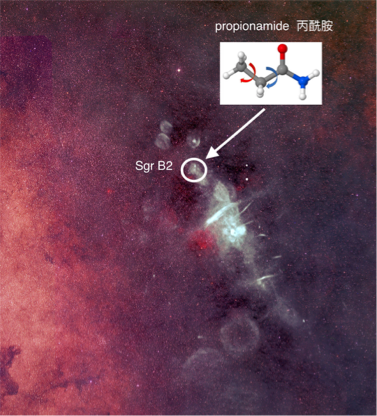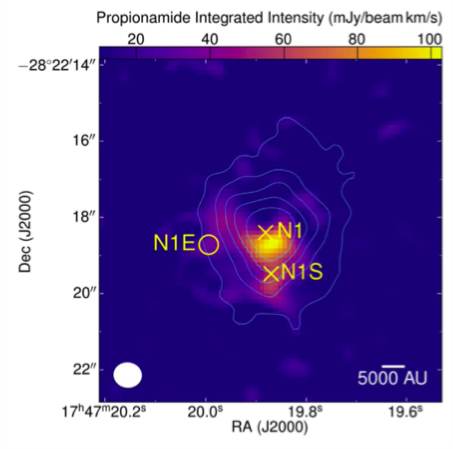First detection of the largest peptide-like molecule in space
Recently, an international group led by Juan Li and Junzhi Wang from Shanghai Astronomical Observatory (SHAO), detected propionamide (C2H5CONH2) toward Sagittarius B2 (Sgr B2) for the first time with the Atacama Large Millimeter/submillimeter Array (ALMA). This is the largest peptide-like molecule detected in space. The study was published in The Astrophysical Journal.

Figure 1 Image of the Galactic center region observed with the Spitzer and Very Large Array (VLA) telescope. White circle indicates Sgr B2.
Image credited: B. Saxton, NRAO/AUI/NSF from data provided by N.E. Kassim, Naval Research Laboratory。
Proteins are polymers of amino acids joined together by the peptide bond -NHCO-. Peptide bonds are the ubiquity structures in proteins and the characteristic structures for proteins. Molecules with peptide-like bonds are of particular interest for our understanding of possible routes of protein formation in space. Among 240 molecules detected in space, only 4 molecules belong to peptide-like molecule, and whether larger peptide-like molecule could be formed in space is unclear.
Sgr B2, the massive star-forming region located close to the Galactic Center, has been found to be one of the best hunting grounds for complex organic molecules in the interstellar medium (ISM). Many prebiotic molecules have been detected in Sgr B2. Observation of Shanghai Tianma 65m telescope have revealed widespread complex organic molecules (COMs) around Sgr B2 (by Li et al. in 2017). The abundant COMs emissions cause serious line-blending in Sgr B2. It is hard to find enough clean transitions, making the identification of new molecules in Sgr B2 particularly difficult.
Based on the ALMA data with the high resolution and high sensitivity, the researchers first found a suitable position to identify propionamide by comparing image of propionamide and the hot core. They found a clean propionamide transition, and obtained its spatial distribution.
They then found a position with relatively high abundance of propionamide by comparing the spatial distribution of propionamide and CH313CN, which traces hot core. They found six clean transitions and 20 partially blended transitions toward this position and their intensity and velocity are consistent with simulations.

Figure 2: Integrated intensity map of 13CH3CN (contours) overlaid on the integrated intensity map of propionamide in color scale. Crosses indicate the position of Sgr B2(N1) and Sgr B2(N1S), while circle indicates position of Sgr B2(N1E) (Li et al. 2021).
The findings of these observations indicated the first detection of propionamide in space.
The observational results indicated that propionamide emission comes from the warm, compact cores in Sgr B2, in which massive protostellars are forming. The column density of propionamide toward Sgr B2(N1E) was derived to be 1.5×1016 cm-2, which is three-fifths of that of acetamide, and one-nineteenth of that of formamide.
The detection of propionamide in Sgr B2(N) demonstrates that interstellar chemistry can reach sufficient levels of complexity to form relatively large peptide molecules, and shows the possible growth of larger amide molecules from smaller ones in a massive star-forming process. It is probable that propionamide might also exist in massive star-forming regions in the Galactic disk, such as Orion KL and NGC 6334.
Paper Link:
https://iopscience.iop.org/article/10.3847/1538-4357/ac091c
Science Contact:
Juan Li, Shanghai Astronomical Observatory, lijuan@shao.ac.cn
Junzhi Wang, Shanghai Astronomical Observatory,zwang@shao.ac.cn
Download attachments: